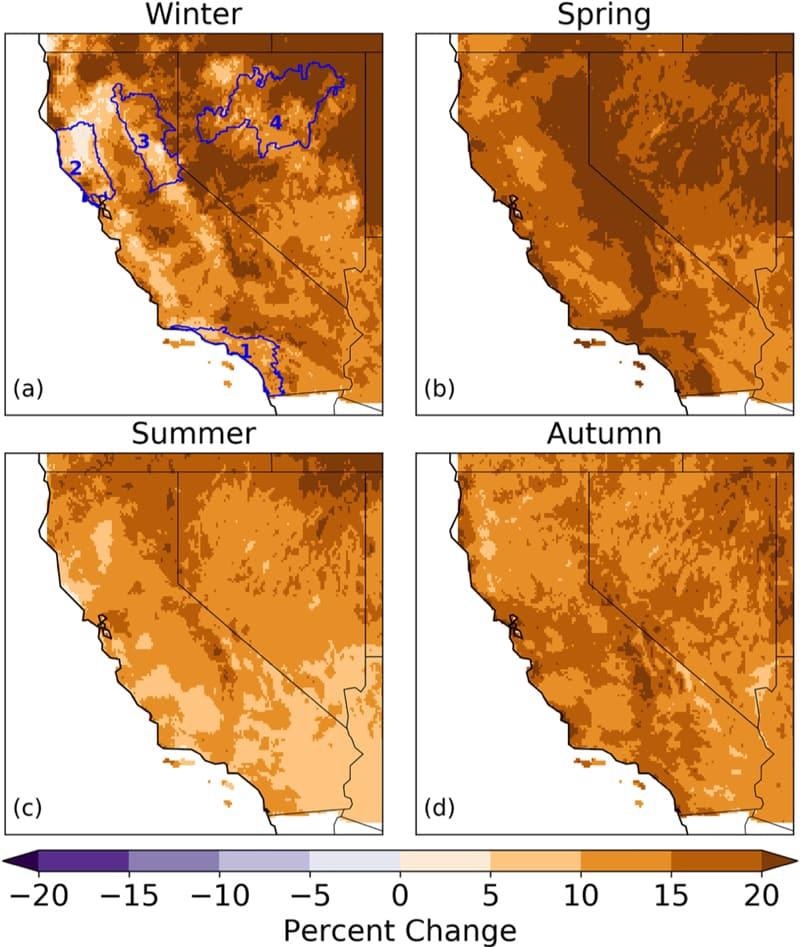Nov 20 2020
According to a new study from the Desert Research Institute (DRI), the Scripps Institution of Oceanography at the University of California, San Diego, and the University of California, Merced, climate change and a “thirsty atmosphere” would result in more extreme wildfire risks and multi-year droughts to California and Nevada by the end of the 21st century.
 Study results show increases of 13%–18% in evaporative demand during all four seasons by the end of the century. Image Credit: Dan McEvoy/DRI.
Study results show increases of 13%–18% in evaporative demand during all four seasons by the end of the century. Image Credit: Dan McEvoy/DRI.
Published in Earth’s Future, the study analyzed future predictions of evaporative demand—a measure of how dry the air is—in Nevada and California through the end of this century.
The researchers studied how variations in evaporative demand would influence the occurrence of extreme fire hazard and three-year droughts, based on metrics from the Standardized Precipitation Evapotranspiration Index (SPEI) and Evaporative Demand Drought Index (EDDI).
The findings of the study reveal that climate change forecasts indicate steady future increases in atmospheric evaporative demand (or the “atmospheric thirst”) over Nevada and California. These variations were mainly triggered by warmer temperatures and would possibly result in major on-the-ground environmental effects.
Higher evaporative demand during summer and autumn—peak fire season in the region—means faster drying of soil moisture and vegetation, and available fuels becoming more flammable, leading to fires that can burn faster and hotter.
Dan McEvoy, PhD, Study Lead Author and Assistant Research Professor of Climatology, DRI
According to coauthor of the study John Abatzoglou, PhD, an Associate Professor at the University of California, Merced, “Increased evaporative demand with warming enables fuels to be drier for longer periods. This is a recipe for more active fire seasons.”
The team learned that days with very high fire hazard in autumn and summer are anticipated to increase 4 to 10 times by the end of this century. The findings also revealed that multi-year droughts, akin to those experienced in Nevada and California during 2012–2016, were predicted to increase 3–15 times by the end of this century.
One major takeaway was that we can expect to see a lot more days in the summer and autumn with extreme fire danger related to increased temperature and evaporative demand. Another takeaway was that even in locations where precipitation may not change that much in future, droughts are going to become more severe due to higher evaporative demand.
Dan McEvoy, PhD, Study Lead Author and Assistant Research Professor of Climatology, DRI
Researchers say that the cumulative impact of increases in evaporative demand will increase fire danger, negatively impact agriculture where water requirements cannot be met, affect native ecosystems, and exacerbate impacts to society during periods of extended dryness.
Many members of the research team are part of the California-Nevada Applications Program (CNAP) and will use the study findings to offer resource managers insights into probable future scenarios.
These results provide information to support science-based, long-term planning for fire management agencies, forest management agencies, and water resource managers. We plan to work with partners to help integrate the findings from this paper to support building climate resilience.
Julie Kalansky, PhD, Study Coauthor and Program Manager, California-Nevada Applications Program
This research was financially supported by the National Oceanic and Atmospheric Administration (NOAA) California-Nevada Climate Applications Program (CNAP) and the NOAA National Integrated Drought Information System (NIDIS) California-Nevada Drought Early Warning System.
Journal Reference:
McEvoy, D, J., et al. (2020) Projected Changes in Reference Evapotranspiration in California and Nevada: Implications for Drought and Wildland Fire Danger. Earth’s Future. doi.org/10.1029/2020EF001736.